This 30-minute Pancit Recipe is one of the easiest Filipino-inspired dishes you could ever make. It’s a perfect one-pan weeknight dinner or party dish that combines seared chicken thighs and pork shoulder with a medley of crisp-tender veggies and stir-fried rice noodles in an incredibly flavorful sauce.
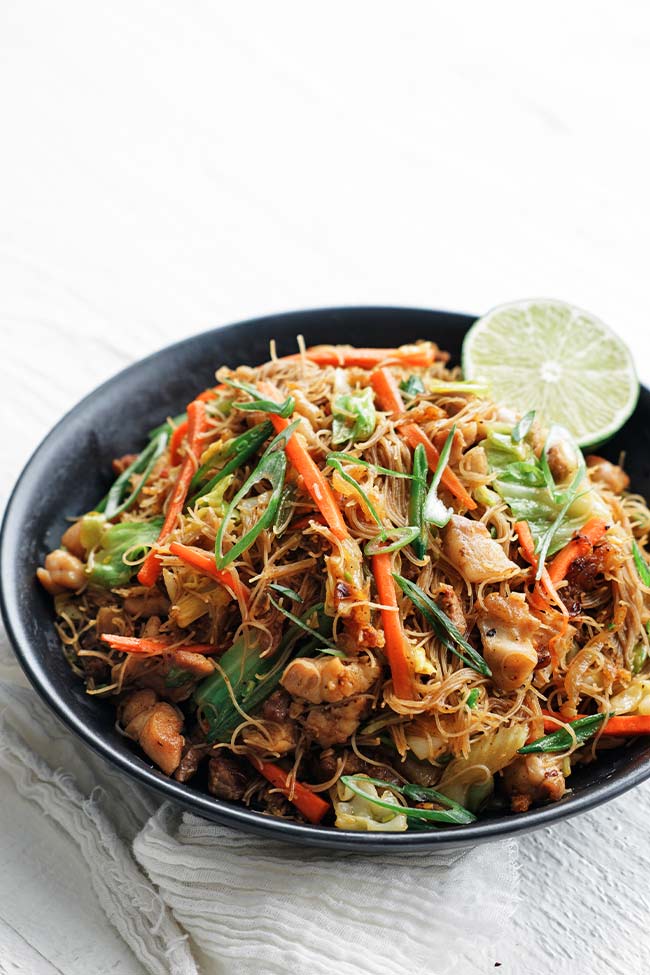
If you aren’t familiar with Filipino food, this easy pancit recipe is an excellent place to start. Each step, from searing the meat to stir-frying the veggies and cooking the noodles in a rich, savory sauce, is beginner-friendly. Plus, you end up with a crowd-pleasing meal every time. If you’re craving even more bold Filipino flavors, this Filipino Chicken Adobo is fantastic.
What is Pancit?
Chinese immigrants introduced stir-fried noodles to the Philippines back in the 16th century. Over time, Filipino cooks adapted the dish using local ingredients and flavors, creating what we now know as pancit. There are many regional variations, but the most traditional versions, such as pancit bihon, feature thin rice noodles stir-fried with a mix of meat, vegetables, aromatics, and a soy-based sauce.
My version of pancit bihon stays true to tradition, using vermicelli noodles. I use a rich, umami-forward sauce and layer in the flavor by first searing the meat, slow-sautéing the aromatics, and flash-cooking the veggies. It’s just as satisfying as the versions you’d find at a Filipino party, and everything still comes together in one pan.
One of the best aspects of Filipino pancit is its versatility. You can switch up the proteins, veggies, and even try different noodles. While thin rice vermicelli noodles are a must for authentic pancit bihon, you could also do pancit canton with flour stick noodles or pancit sotanghon with cellophane/glass noodles. It’s up to you!
Ingredients and Substitutions
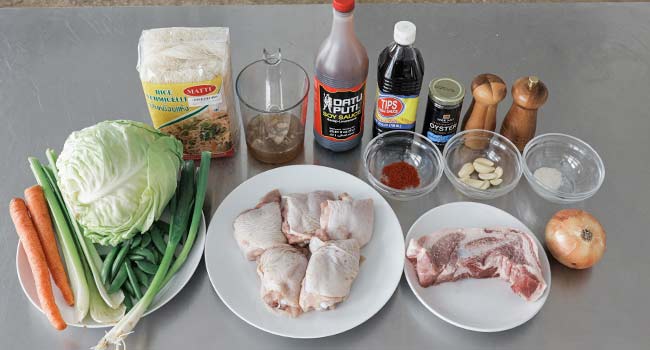
- Oil – I cooked the meats and veggies in a neutral, high-heat oil, such as avocado, canola, or vegetable oil.
- Pork – Pork shoulder, cut into ½-inch cubes, is my go-to choice for its flavor and tenderness after a quick sear. Pork belly also works well if you like the extra richness. Pork loin is leaner and slightly firmer, making it a good option for those who prefer a lighter dish.
- Chicken – I like using boneless chicken thighs cut into 1-inch cubes. They’re more forgiving and stay juicy even when cooked over high heat, but you can use chicken breasts if that’s what you have on hand. Just keep an eye on them to prevent the meat from drying out.
- Aromatics – I sautéed yellow onions and garlic cloves to create a sweet and savory flavor foundation.
- Achiote Powder – AKA annatto powder. This comes from achiote or annatto seeds from the achiote tree, also known as the Bixa Orellana. This ingredient is optional.
- Vegetables – Carrots, celery, snap peas, and cabbage bring crunch and color to the dish. Feel free to mix and match these veggies with anything you like. You could even use a bag of pre-shredded carrots and cabbage to save time.
- Sauce – I made the pancit sauce with a blend of oyster sauce, granulated sugar, soy sauce, fish sauce, and chicken stock. Fish sauce is optional, but I find that its subtle briny notes make a difference.
- Noodles – Look for Filipino instant noodles or rice vermicelli noodles labeled pancit bihon. These come in a dried bundle. If you can’t find them, flour stick noodles (pancit canton) or glass noodles (pancit sotanghon) soak up the sauce just as well.
- Seasonings – Just coarse salt and freshly cracked black pepper.
- Garnishes – I squeeze lemon or lime juice over the top right before serving to bring out the flavors. I also add green onions for a crisp, peppery finish.
How to Make Pancit
Cook the pork: First, I heat the oil in a large wok over medium-high heat. When it starts to smoke, I add the pork, season it with salt and pepper, and stir-fry until it’s browned on all sides and cooked through. I set the pork aside in a large bowl.

Sear: I heat another tablespoon of oil in the wok, then add the chicken, season it with salt and pepper, and sear it until it has a golden crust. After that, I stir-fry the chicken just until it’s cooked through, then set it aside with the pork.
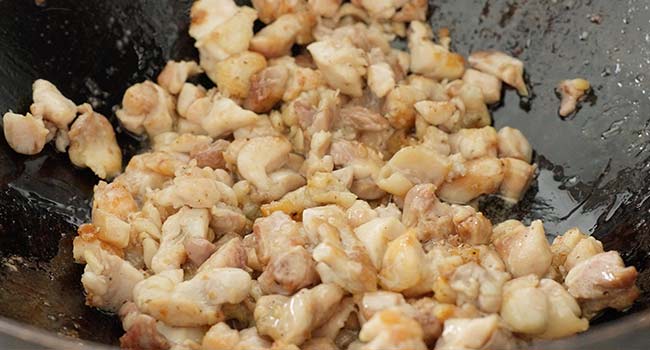
Sauté: Next, I sauté the sliced onions and a pinch of salt in the rendered fat over low to medium heat until they turn golden brown and tender. Then, I stir in the garlic and add the achiote powder. I give this mixture a good stir, then set it aside with the meat.
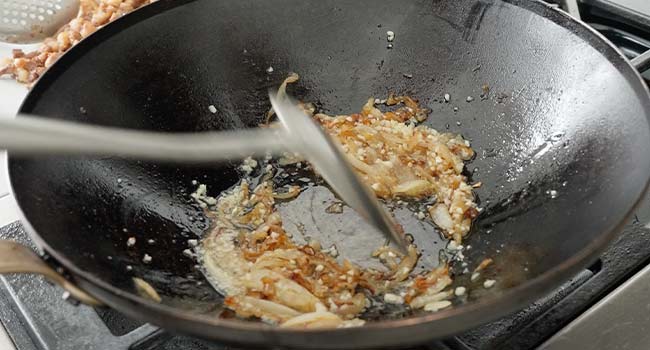
Stir fry: I add the last bit of oil to the wok, then add the carrots, celery, snap peas, and cabbage. I season them lightly with salt and stir-fry them for about 90 seconds. Then, I add them to the bowl with everything else.
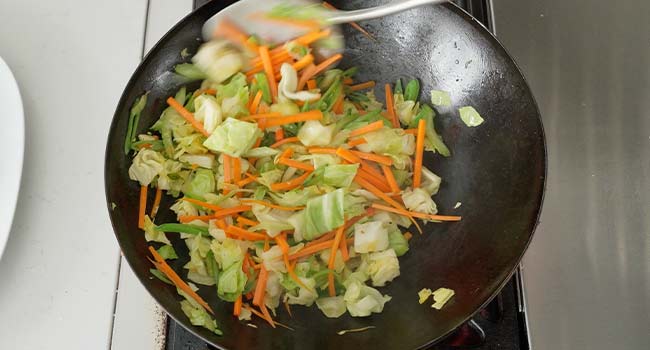
Simmer: To make the sauce, I reduce the heat before pouring the oyster sauce, sugar, soy sauce, fish sauce, and chicken stock into the wok. I heat it to a gentle simmer.
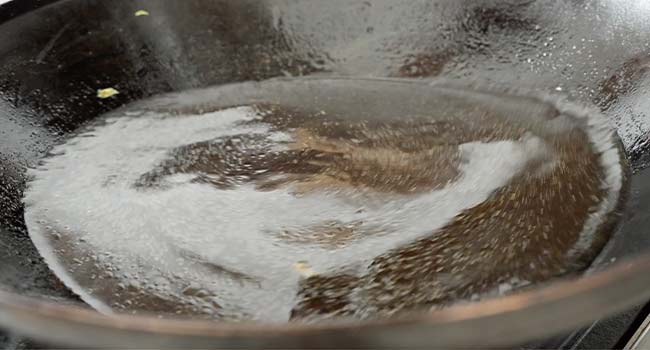
Cook the noodles: I add the noodles to the simmering sauce and gently move them in the pan until they are soft and have absorbed the liquid.
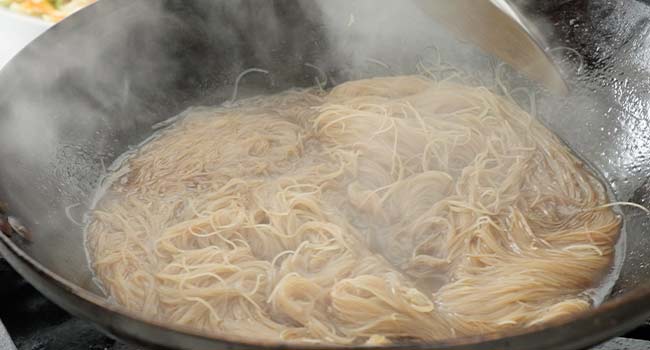
Combine: I return the cooked pork, chicken, aromatics, and vegetables to the wok and toss everything in the sauce.
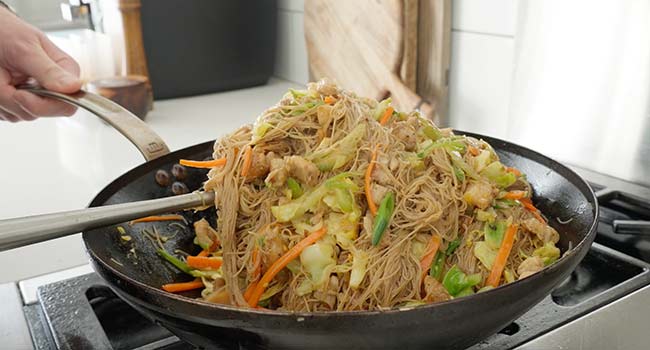
Serve: I garnish the dish with fresh citrus juice and thinly sliced green onions before serving.
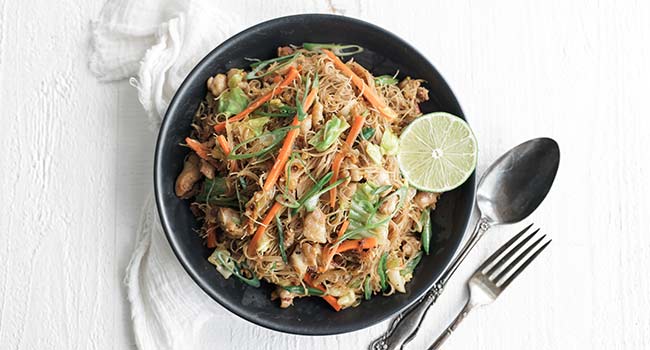

Chef Tips + Notes
Vermicelli noodles are exceptionally delicate, and leaving them on the heat too long will make them mushy. To prevent overcooking, keep the noodles moving in the simmering sauce. Cook them just until they absorb the liquid and become tender. If your noodles are still too dry after 3 to 4 minutes, add more stock and continue stirring until they are tender.
- Practice mise en place: This dish moves very quickly, and it’s essential to have all your ingredients measured, chopped, and ready to go before firing up the wok. You don’t want to be scrambling to cut meats, chop veggies, or open sauces mid-recipe.
- Chop everything evenly: Try to slice your proteins into even, bite-sized pieces (½ to 1-inch cubes) and slice your veggies thinly to help them cook through evenly and quickly.
- Trust the multi-step process: Overcrowding the pan with both the pork and chicken will cause the meat to steam instead of sear. For the best results, sear the proteins separately in a single layer to get a nice golden-brown crust. Also, take your time when caramelizing the onions, as this will slowly bring out their natural sweetness and add complexity to this noodle dish. Don’t rush this step!
- Customize the ingredients and flavors: Pancit bihon is incredibly adaptable. You can easily substitute the chicken and pork with shrimp and steak, and use any vegetables you like or already have on hand in your fridge. Bok choy, bell peppers, green beans, mushrooms, and/or bean sprouts would all be delicious add-ins.
- Skip the pork: You can make this dish using only chicken, but if you have a little extra pork on hand, this is a great recipe to use it in.
Serving Suggestions
I like to keep the meal true to tradition when I’m serving pancit for dinner. This means pairing it with other classics for a full-on festive Filipino-inspired feast, such as lumpiang shanghai (crispy pork spring rolls), bistek tagalog, or lechon kawali (crispy pan-fried pork belly).
If you’re serving this for a weeknight dinner or casual get-together, feel free to branch out a bit. It also goes great with a simple salad, sautéed green beans, or a side of steamed rice if you have a hungry crowd.
Make-Ahead and Storage
Make-Ahead: Pancit is best served immediately, as the noodles will become soggy if left to sit. To get a head start, you can slice the vegetables and aromatics, cube the pork and chicken, and mix the sauce ingredients one day in advance. Keep everything in airtight containers in the fridge until you’re ready to cook.
How to Store: Store the cooled pancit leftovers in an airtight container in the fridge for up to 3 days. It will also freeze well for up to 2 months. Just thaw the noodles overnight in the refrigerator before reheating.
How to Reheat: Toss the noodles in a skillet over medium heat with a splash of water or chicken stock to rehydrate the leftovers and make them saucy again.
More Stir-Fry Recipes

Video
Pancit Recipe
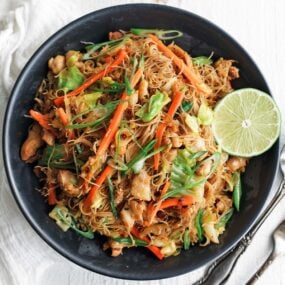
Ingredients
- 4 tablespoons neutral-flavored oil
- 8 ounces pork shoulder, belly, or loin cut into ½” cubes
- 1 pound boneless chicken thighs, cut into 1” cubes, skin optional
- 1 peeled, julienne medium-sized yellow onion
- 7 to 8 finely minced garlic cloves
- ½ teaspoon ground achiote powder, optional
- 2 peeled, julienne medium-sized carrots, about 1 cup
- 2 ribs of celery, thinly sliced on a bias, about 1 cup
- 1 cup sugar snap peas, thinly sliced on a bias
- 4 cups green cabbage, cut into 1” pieces
- 3 tablespoons oyster sauce
- ½ teaspoon granulated sugar
- 3 tablespoons soy sauce
- 1 to 2 teaspoons fish sauce, optional
- 4 cups of chicken stock
- 8 ounces of vermicelli noodles
- coarse salt and freshly cracked pepper to taste
- lemon or lime juice, optional.
Instructions
- Add 2 tablespoons of oil to a large wok over medium-high heat and heat until it begins to smoke lightly. Place the pork in the pan, season with salt and pepper, and stir-fry until browned on all sides and cooked through. This will take about 3 to 4 minutes. Set it aside in a large bowl or platter.
- Next, pour in 1 more tablespoon of oil, add the chicken, season with salt and pepper, and cook for 2 to 3 minutes without stirring. Then, stir-fry for 3 to 4 minutes, until well-browned and cooked through. Set it aside with the pork.
- In the leftover rendered fat, add the onions, gently season with salt, and cook over low to medium heat for 10 to 12 minutes, stirring frequently, until they are browned and tender. Stir in the garlic and cook for only 30 to 45 seconds. Then, stir in the optional achiote powder and mix until well combined. Set it aside with the pork and chicken.
- Add the remaining oil, turn the heat to high, and add the carrots, celery, snap peas, and cabbage. Gently season with salt, then stir-fry for 90 seconds. Set it aside with the pork, chicken, onions, and garlic.
- In the wok over medium heat, add the oyster sauce, sugar, soy sauce, fish sauce, and chicken stock, and bring to a simmer.
- Once simmering, add the noodles and cook, stirring constantly, until they have absorbed all the liquid and are cooked, which takes about 3 to 4 minutes.
- Add the cooked meat and veggies to the wok and stir until combined.
- Garnish with a squeeze of lime or lemon juice, and optionally, sliced green onions.







Nicely done, Chef! It was a complete hit!
Excellent!
Oh my gosh!
This was SO Delicious! Definitely making it again, just as you have dictated!
Excellent!
Chef, you nailed this recipe. From a Filipino, I have to tell you that I am amazed at all the different Filipino recipes you’ve shared with your own personal touch. I cannot wait for more delicious flavors from you. I’ve tried the Bistek, Adobong Manok (chicken adobo) and this. Just so far the best dishes. Thank you!
Excellent!
I work with a Gal who is going to love this dish! We trade food all the time. I can’t wait to make this one to share with her!
TU so much ChefBilly loving your recipe ‘s..&videos 😁👋😋
TUChef Billy live this all in one pot 🤩😋so yummy 🤤👋😁whooo
I LOVE all your recipes! This one is simple, adaptable and nutritious! Made it, ate it and LOVED it! Thank you again for sharing. I hope you consider writing a cookbook. It would be a sell-out in no time! Bravo, Billy!
So good!!